.
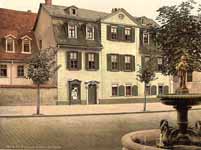
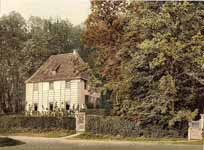
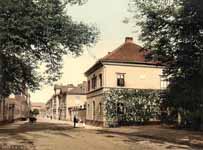
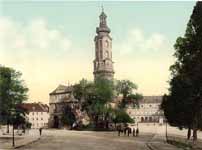
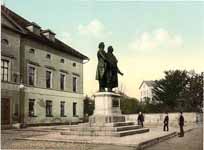
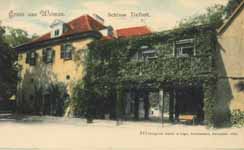
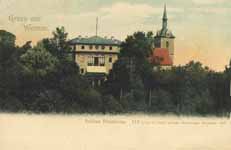
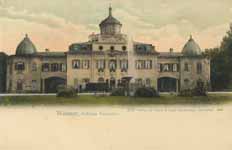
10, 11,
Weimar (German pronunciation: [ˈvaɪmaɐ]) is a city in Germany famous for its cultural heritage. It is located in the federal state of Thuringia (German: Thüringen), north of the Thüringer Wald, east of Erfurt, and southwest of Halle and Leipzig. Its current population is approximately 65,000. The oldest record of the city dates from the year 899. Weimar was the capital of the Duchy (after 1815 the Grand Duchy) of Saxe-Weimar (German Sachsen-Weimar).
Weimar's cultural heritage is vast. It is most often recognised as the place where Germany's first democratic constitution was signed after the First World War, giving its name to the Weimar Republic period in German politics, of 1918–1933. However, the city was also the focal point of the German Enlightenment and home of the leading characters of the literary genre of Weimar Classicism, the writers Goethe and Schiller. The city was also the birthplace of the Bauhaus movement, founded in 1919 by Walter Gropius, with artists Wassily Kandinsky, Paul Klee, Oskar Schlemmer, and Lyonel Feininger teaching in Weimar's Bauhaus School. Many places in the city centre have been designated as UNESCO World Heritage sites.
Geography
General
Thuringia is one of the smallest states in Germany. The city of Weimar is classified as an independent city district, in addition to the 17 districts (Landkreise) and 5 other independent cities of Thuringia. Weimar is the 4th largest city in Thuringia, with a population of approximately 65,000 people.
The city limits of Weimar itself are approximately 7 km and the neighbouring cities are Jena and Erfurt, the capital of Thuringia. The city lies along the River Ilm. In the valley of the river Ilm river the federal Motorway 87 runs from Ilmenau to Leipzig and two railways: the Ilmbahn between Kranichfeld and Weimar and the highspeed railway from Berlin to Frankfurt am Main between Weimar and Großheringen.
The city is north-east of the Thuringian Forest, 25 minutes away by autobahn or train.
City districts
Ehringsdorf
Gaberndorf
Gelmeroda
Holzdorf
Legefeld
Niedergrunstedt
Oberweimar
Possendorf
Schöndorf
Süßenborn
Taubach
Tiefurt
Tröbsdorf
History and Culture
The Grand-Ducal Palace.
Photograph of a large bronze statue of two men standing side-by-side and facing forward. The statue is on a stone pedestal, which has a plaque that reads "Dem Dichterpaar/Goethe und Schiller/das Vaterland". Behind the monument there is a large, 3-storey building with an elaborate stone facade.
The Goethe-Schiller Monument in front of the Deutsches Nationaltheater and Staatskapelle Weimar.
The oldest records about Weimar date back to the year 899. Its name changed over the centuries from Wimares through Wimari to Wimar and finally Weimar; it is probably derived from Old High German wih 'holy' + mari 'standing water, swamp'.[2] (Another theory derives the first element from OHG win 'meadow, pasture.'[3]) In 1410 it received city rights, although the growth of the city was severely affected by the 1424 fires.
In 1552 Weimar became the capital of the Duchy of Saxe-Weimar (German Sachsen-Weimar) and remained so until 1918.
18th and 19th centuries
During the regencies of Anna Amalia (1758–1775) and her son Carl August (1809–1828), Weimar became an important cultural centre of Europe, having been home to such luminaries as Goethe, Schiller, and Herder; and in music the piano virtuoso Hummel (a pupil of Mozart), Liszt, and Bach. Richard Strauss worked in Weimar for 5 years as second conductor in the acclaimed Staatskapelle Weimar (the court orchestra founded in 1491). Several of his encores for works such as Hansel and Gretel, Don Juan and Macbeth were performed by the Staatskapelle Weimar. It has been a site of pilgrimage for the German intelligentsia since Goethe first moved to Weimar in the late 18th century. Goethe was also active in civic duties while living in Weimar. He served as Privy Councilor to the Grand Duke of Saxe-Weimar-Eisenach for an extended period. The tombs of Goethe and Schiller, as well as their archives, may be found in the city. Goethe's Elective Affinities (1809) is set around the city of Weimar.
Weimar Republic
For more details on this topic, see Weimar Republic.
The period in German history from 1919 to 1933 is commonly referred to as the Weimar Republic, as the Republic's constitution was drafted here because the capital, Berlin, with its street rioting after the 1918 German Revolution, was considered too dangerous for the National Assembly to use it as a meeting place.
The Bauhaus Movement
Walter Gropius founded the Bauhaus School and movement in Weimar in 1919. The School aimed to teach and develop modernist style. The Bauhaus University and the Liszt School of Music Weimar, attracted many students, specializing in art, media and design, architecture, civil engineering and music. The Bauhaus in Weimar lasted from 1919 to 1925, when it moved to Dessau, after the newly-elected right-wing city council put pressure on the School by withdrawing funding and forcing its teachers to quit.
Many buildings in Weimar today have influences from the Bauhaus period. However, only one original Bauhaus building was constructed during 1919-1925, the Haus am Horn, now used for exhibitions and events on Bauhaus culture. The Bauhaus Museum, on Theaterplatz, offers an exhibition of works from the Bauhaus period in Weimar and screens an informative film about the movement's influences on Weimar city.
Nazi Germany and World War II
Buchenwald's main gate, with the slogan Jedem das Seine (literally, "to each his own", but figuratively "everyone gets what they deserve")
In 1937, the Nazis constructed the Buchenwald concentration camp, only eight kilometres from Weimar's city centre. The slogan Jedem das Seine (literally "to each his own", but figuratively "everyone gets what he deserves") was placed over the camp's main entrance gate. Between July 1938 and April 1945, some 240,000 people were incarcerated in the camp by the Nazi regime, including 168 Western Allied POWs.[4] The number of deaths at Buchenwald is estimated at 56,545.[5] The Buchenwald concentration camp provided slave labour for local industry (arms industry of Wilhelm-Gustloff-Werk).[6]
The Allied ground advance into Germany reached Weimar in April 1945, and the city surrendered to the US 80th Infantry Division on April 12, 1945. [7] The residents of Weimar were ordered to walk through Buchenwald, to see what had been happening so close to the city, as documented in Billy Wilder's film Death Mills. The city ended up in the Soviet zone of occupation, however, so US troops were soon replaced with Russian forces. From 1945 to 1950, the Soviet Union used the occupied Buchenwald concentration camp to imprison defeated Nazis and other Germans. The camp slogan remained Jedem das Seine. On 6 January 1950, the Soviets handed over Buchenwald to the East German Ministry of Internal Affairs.
German Democratic Republic (East Germany)
Weimar was part of the German Democratic Republic (DDR, East Germany) from 1949 to 1990.
Recent years
The European Council of Ministers selected the city as European Capital of Culture for 1999.
On 2 September 2004, a fire broke out at the Duchess Anna Amalia Library. The library contains a 13,000-volume collection including Goethe's masterpiece Faust, in addition to a music collection of the Duchess. An authentic Lutheran Bible from 1534 was saved from the fire. The damage stretched into the millions of dollars. The number of books in this historic library exceeded 1,000,000, of which 40,000 to 50,000 were destroyed past recovery. The library, which dates back to 1691, belongs to UNESCO world heritage, and is one of the oldest libraries in Europe. The fire, with its destruction of much historical literature, amounts to a huge cultural loss for Germany, Europe, and indeed the world. A number of books were shock-frozen in the city of Leipzig to save them from rotting. On 24 October 2007 the library reopened. Visitors were advised to book their tickets many months in advance.
Liszt Year 2011
Weimar and the state Thuringia are celebrating Liszt's 200th birthday in 2011.
Places of interest
National Goethe Museum and Goethe House
Goethe's Gartenhaus
Schiller House and the Schiller Museum
Historical Cemetery with final resting place for Goethe, and Schiller's coffin but without Schiller's mortal remains
Ilm Park
Wittumspalais
Liszt Museum
Palace Museum
German National Theatre
Neues Museum Weimar
Bauhaus Museum
Main building of the Bauhaus University (planned by Henry van de Velde)
Buchenwald Memorial
Nietzsche Archiv
Schlossmuseum
Schloss Tiefurt
Schloss Kochberg
Schloss Belvedere
Eisenbahnmuseum Weimar (Train Museum)
Onion Market
The Onion Market (Weimarer Zwiebelmarkt) is an annual festival held in October in Weimar and it is Thuringia's largest festival. The festival is held over 3 days and approximately 500 stalls and more than 100 stage performances are put up across the city.
Weimar first celebrated the Onion Market in 1653. The 2011 Onion Market – the 358th – will see again over 300,000 visitors. Stalls typically offer onion plaits, themed arts and crafts and numerous onion-based foods, including onion cakes, onion soups and onion breads. The festival also hosts numerous beer gardens, live music, fairground attractions and a Ferris wheel.
Famous residents of Weimar
Schiller House.
Goethe's garden house.
Liszt House.
Anna Amalia
Johann Sebastian Bach
Hector Berlioz
Hans von Bülow
Peter Cornelius
Lucas Cranach the Elder
Marlene Dietrich
Johann Peter Eckermann
Lyonel Feininger
Paul Feyerabend
Caspar David Friedrich
Uziel Gal
Johann Wolfgang von Goethe
Walter Gropius
Nina Hagen
Johann Gottfried Herder
Johann Gottfried Walther
John Horrocks[disambiguation needed ]
Johann Nepomuk Hummel
Johannes Itten
Joseph Joachim
Wassily Kandinsky
Harry Graf Kessler
Paul Klee
Franz Liszt
Martin Luther
László Moholy-Nagy
Friedrich Nietzsche
Friedrich Preller the Elder
Friedrich Preller the Younger
Joseph Joachim Raff
Friedrich Schiller
Oskar Schlemmer
Arthur Schopenhauer
Frédéric Soret
Rudolf Steiner
Richard Strauss
Henry van de Velde
Richard Wagner
Christoph Martin Wieland
Carl Zeiss
Education
Universities
Bauhaus-Universität Weimar (formerly known as Art Academy of Weimar and after 1945 University for Architecture and Civil Engineering) currently has approximately 4,500 students in 4 faculties (Architecture, Engineering, Design, and Media). The buildings of the University have been on the UNESCO World Heritage list since 1996.
Hochschule für Musik Franz Liszt (affiliated with the Friedrich-Schiller-Universität Jena and the Institut für Musikwissenschaft Weimar-Jena) currently has approximately 850 students.
Europäische Jugendbildungs- und Jugendbegegnungsstätte Weimar
Archives
Thuringia Central Archive
Weimar City Archives
Goethe and Schiller Archive
Modernist Archive
Libraries
Herzogin Anna Amalia Bibliothek 1991
State Library
Herzogin Anna Amalia Bibliothek (HAAB) (pictured)
Bauhaus University Library (Universitätsbibliothek/UB der Bauhaus-Universität)
Library for the University of Music (Bibliothek der Hochschule für Musik)
GDR Library at Taubach
Literary Societies
Goethe-Gesellschaft (Weimar, 1885)
Gesellschaft der Bibliophilen (Weimar, 1899)
German Schiller Society
Deutsche Shakespeare Gesellschaft
Nightlife
There are several clubs with live music once or twice a week. The two student clubs in the city centre also feature disco and live music events on Friday- and Saturday nights (Studentenclub Schützengasse, Kasseturm). There are several smaller theatre and cabaret venues other than the large "DNT" (Deutsches National Theater). There are four cinemas including a 3-D cinema.
Transport
Weimar Central Train Station
For a small city, Weimar is well served by city bus routes, which also serve all of the annex towns and villages. An hourly bus route serves the Buchenwald Memorial. There are also many places to rent bikes in the city centre. Weimar is part of the Goethe cycle tour route and the Ilm Valley cycle tour.
Weimar is connected by one motorway, the Autobahn A4 (A4) and two routes: B7 and B85
Weimar station is on the ICE express train line (ICE) from Frankfurt, to Dresden and Berlin, with trains stopping every hour. The ICE service to Leipzig takes 50 minutes and the service to Dresden takes two hours. There are frequent train services to neighboroung cities Erfurt (westbound) and Jena (eastbound), taking approximately 15 minutes to either city.
The nearest airports are Erfurt and Leipzig-Halle.
International relations
Main article: List of twin towns and sister cities in Germany
Weimar is twinned with:
France Blois, France
Iran Shiraz, Iran
Finland Hämeenlinna, Finland
Italy Siena, Italy
Germany Trier, Germany
See also
World Heritage Site
Weimar Classicism
References
^ "Bevölkerung nach Gemeinden, erfüllenden Gemeinden und Verwaltungsgemeinschaften" (in German). Thüringer Landesamt für Statistik. 27 June 2011.
^ Gitta Günther, Wolfram Huschke, and Walter Steiner, Weimar (Böhlau, 1993), p. 494.
^ Adrian Room, Placenames of the World: Origins and Meanings of the Names for over 5000 Natural Features, Countries, Capitals, Territories, Cities and Historic Sights (McFarland, 2003: ISBN 0786418141), p. 387.
^ Bartel, Walter: Buchenwald—Mahnung und Verpflichtung: Dokumente und Berichte (Buchenwald: Warnings and our obligation [to future generations]—Documents and reports), Kongress-Verlag, 1960. p. 87, line 8. (German)
^ Podcast with one of 2000 Danish policemen in Buchenwald. Episode 6 is about statistics for the number of deaths at Buchenwald.
^ Edward Victor.Alphabetical List of Camps, Subcamps and Other Camps.www.edwardvictor.com/Holocaust/List %20 of %20 camps.htm
^ Stanton, Shelby, World War II Order of Battle: An Encyclopedic Reference to U.S. Army Ground Forces from Battalion through Division, 1939-1946, Stackpole Books (Revised Edition 2006), p. 150
From Wikipedia, All text is available under the terms of the GNU Free Documentation License
Weimar
